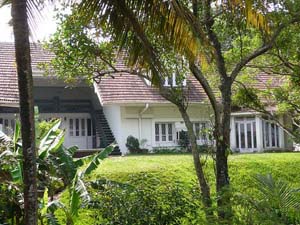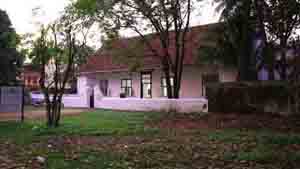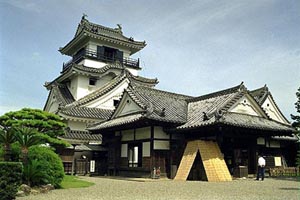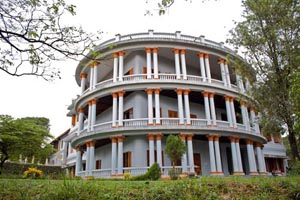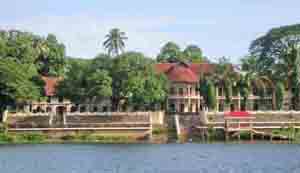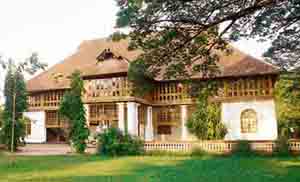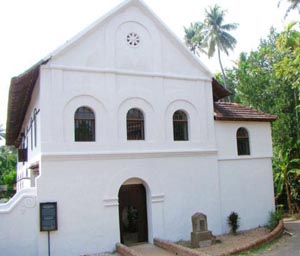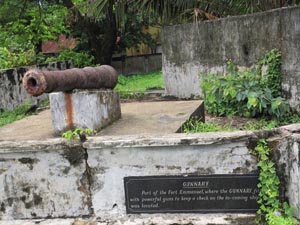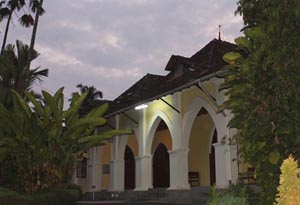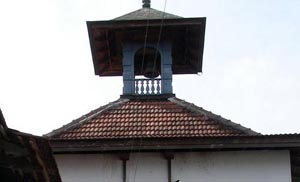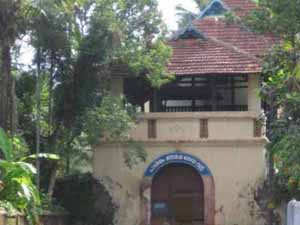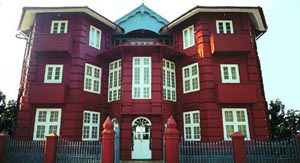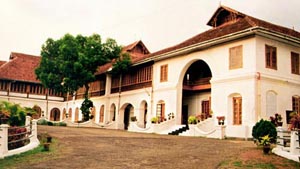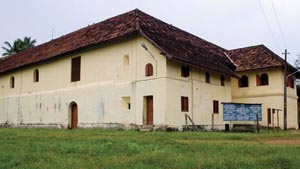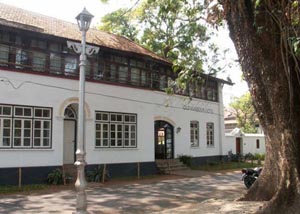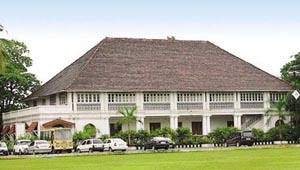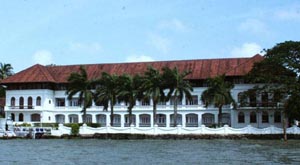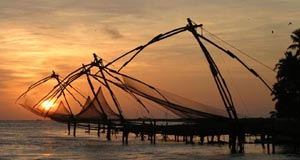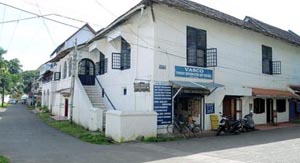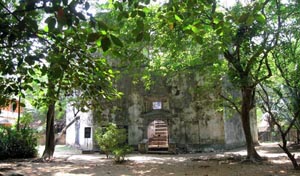Ernakulam Monuments - Historical Places to Visit in Ernakulam
Historical Monuments / Forts / Palaces / Places to Visit in Ernakulam
Here you can check list of names and information on famous historical forts / palaces / monuments / places to visit in Ernakulam, Kerala, India. These famous monuments of Ernakulam are most visited and most sought after best tourist places. You can also find images of Ernakulam monuments / places / forts / palaces.
Bastion Bungalow was built in the early (17th century AD) by the Dutch. They came here for spice trade with India. They built this Bungalow as their residence and office space. The entire building is built of woods, granites, mount clay bricks, clay tiles, lime stones and red sand bricks. The granites and mount clay bricks are laid on the main base foundations to last longer. Red clay bricks are found on the inner rooms and halls. Lime stone mixing some natural wax was the paste of cement in those days.
David Hall was built around 1690's by the Dutch Imperialist in Malabar province. This palace was built for official purpose and accommodated many Dutch officials and military personals who visited Cochin from the period of 18th century onwards. This bungalow was totally built in the Dutch model, which attracted many people's going around by. The entire edifice is built of granite stones, teak woods and lime stones.
Fort Kochi is surrounded with European architectural marvels. There are many historical monuments were built from the 15th Century AD to the end parts of the 19th century AD. There are many forts, palaces, and worship places built here by the colonial peoples. They made this place as a well organized city in their time itself. The western impact was seen here in social, cultural and architectural works. It was the home left over by the Portuguese, Dutch's, French's and the British's.
Hill Palace Museum is a largest palace and museum built on traditional Kerala architectural pattern. It is placed in a higher elevation on Mulamthurathi. This palace was the official and residential complex for the Kochi Clans. It had 49 edifices built on remarkable designs in an area of 22 hectare of land surrounded by lovely gardens and gorgeous woods. The building materials used her are large clay bricks and granite rocks.
The river that flows parallel to the palace enhance its beauty to a greater extent. There are also gardens inside the palace that depicts the influence of the Hindu architectural style. Again there are circular within the palace from which the beautiful view of the Periyar River is apparent. The architectural composition of the palace also portrays the traditional culture of Kerala in the ancient days.
Bolgatty Palace is built on the European model. The building material used were the most commonly found sea rocks, clay tiles, teak woods, clay bricks and mount bricks. This is mostly built like a mansion to occupy the colonial officials. There are many living rooms, a swimming pool, and golf court. There are many boat platforms built around its shore to reach here from all direction of this Island. This palace is totally built in luxury and comforts articles brought from European countries.
Chendamangalam Fort is built around 1551 AD. It is still standing great at Chendamangalam citadel. It is the architectural significance of the past glory. In the colonial times many Christian missionaries stayed here and propagated Christianity in Kerala State. It was the official residence of Cochin's Prime Minister in the 18th centuries. Later part was occupied by the British East India Company officials. This fort has witnessed all colonial aggression in the history of the past 500 years.
Fort Immanuel is built with the permission from Travancore Maharaja by the Portugal Imperialists. This fortification was mainly built here for there interest in trade and their own security purpose. This is one of the largest forts on the Backwaters of Kerala. This was built with sea rocks, mount clay rocks and granite stones with lime stone paste as its fixers. It has a large thick wall along with the backwaters. On the interior it had many teak woods and iron bar supports.
Indo Portuguese Museum is built inside the bishop house which was built by the Portuguese in the year (1506 AD) in a mix of Indo European architectural pattern. The Indo Portuguese Museum built inside the bishop house, which also resembles the same architectural design. The construction material used here are large bricks blocks, granite stones, clay tiles teak woods and glasses. This edifice is more over a rectangular shape with one storied floor. Its roof tops are wrapped up with clay tiles in the typical Indian form.
Jewish Synagogue in Mattancherry is built and renovated many times in the passage of colonial history. It is built on the 'thachusasthra' pattern of architecture existed in the 15th century AD in Kerala in traditional manner with simple square stricter supported with bamboos and palm leaves. It was in the advent of 16th century AD, when the Portuguese came here for trading and they introduced the modern craftsmanship of European style
The Paliath Achans was the chief minister of the then maharaja who was ruling Kochi. During the period of 1600s the maharaja was dealing with issues of security threat owing to the presence of the Portuguese intruders. It was during this period that the raja was accompanied by the Paliath Achans upto Chendamangalam. After this incident, the Paliath Achans stayed under wraps for quite a long in a place near to Kalari. This further led to the establishment of Paliam Kovilakom palace in the 16th century.
Koder House is a built in a combination of the Dutch and Portugal pattern of architecture. Basically it was meant for a family residential house, but Koder built it differently that no other house matches this building in that area. He added a mix of contemporary and Neo Colonial style of luxury in its structure. This mansion was constructed with Red bricks, granite stones, rock debris, clay tiles, teak woods and Belgium glasses. It is a 3 storied mansion built elegantly on a strong teak wood ceiling.
Maritime Museum totally reflects the construction of the ships from the Indus valley Civilization (2600 BC) to the present days. It has many models ship building process kept here. There are also drawings in colorful forms to show the sea and its functions. There are medieval period telescopes kept here by which many explorers traveled around the world to find new lands. Many ancient maps of the world sketched by these explorers are put on display.
Mattancherry Palace is an Indo European architectural marvel. It is built in a quadrangular model, with the traditional practice of Nalukattu principals of construction prevailed in that time. The location chosen by them is an incredible example of vasthu sashtra. The raw material used here are the laterite stones, rock dust, clay tiles and the woods. This is a single storied structure with many doors and windows surrounded by it.
Old Harbour House is a single storied bungalow built in the European architectural model. This structure is built out of the locally found laterite stones which are available in Cochin and nearby areas. It is a rectangular shaped huge building with 13 large spacious rooms, as well as many small rooms, halls, verandahs, balconies, chimneys and a swimming pool. One of the rooms was a Bastion room to safe guard its resident people in times of crises.
Pareekshith Thampuran Museum was previously the Durbar house of the Kochi royal clans, which used to accommodate its royal guests, including the colonialists of that era. It was solely the Kochi royal property until it was taken by the Kerala archeological departments and converted it as museum for preserving the Kochi Royal history and antiquities. This museum was named after its last ruler of Kochi before the India's Independence named as Darsanakalanidhi Parikshith Thampuran.
Pierce Leslie Bungalow is laid on plain Island grounds on the backwaters. The location chosen is a distinct place. This entire structure was constructed for the purpose of mansion housing. The land and the building are in a large rectangular type model. This was built on a European, mainly the Dutch and Portugal architect with a mix of Kerala style of craftsmanship finishing all around the bungalow. This is a single storied bungalow, which used granites stones for its foundations.
Chinese Fishing Nets is a very simple apparatus to catch fish in still water areas. Like backwaters, lakes and large ponds were water movements are calm. The materials used to build these fishing nets, require few strong and long bamboo sticks, which are the main skeletal parts. A thick wooden panel is needed as such a man can walk up and down on it. If woods panels are not there they used to make it by tying up of bamboo stick together itself. An oil lit lamp as feeder or earth worms.
Vasco House was built by Portuguese. It is a unique single storied building in the European style, which was built 500 years ago by the Portugal colonialist. This was the first modern house ever built in that area. This complete building was built of granite stone and laterite stones. The overall building is pasted with lime stone for stronger life. It has a side way steps to reach its first stories. Here you can find a grilled metal door on the entry. Its ground floor has a center entry with wooden doors.
Pallipuram Fort is a great Island fort in Kochi (Cochin), built by the Portugal in the advent of 16th century AD. It is the only fort, which is in its shape till today in India. This for is a popular fort for having six side fortification, which is visited by tourist daily at Pallipuram P.O, Vyppin Taluk, Ernakulum District, Kerala State of South India.
- Andaman Nicobar Monuments
- Andhra Pradesh Monuments
- Assam Monuments
- Bihar Monuments
- Chhattisgarh Monuments
- New Delhi Monuments
- Goa Monuments
- Gujarat Monuments
- Haryana Monuments
- Himachal Pradesh Monuments
- Jammu and Kashmir Monuments
- Karnataka Monuments
- Kerala Monuments
- Madhya Pradesh Monuments
- Maharashtra Monuments
- Odisha Monuments
- Punjab Monuments
- Rajasthan Monuments
- Tamil Nadu Monuments
- Telangana Monuments
- Uttar Pradesh Monuments
- West Bengal Monuments
